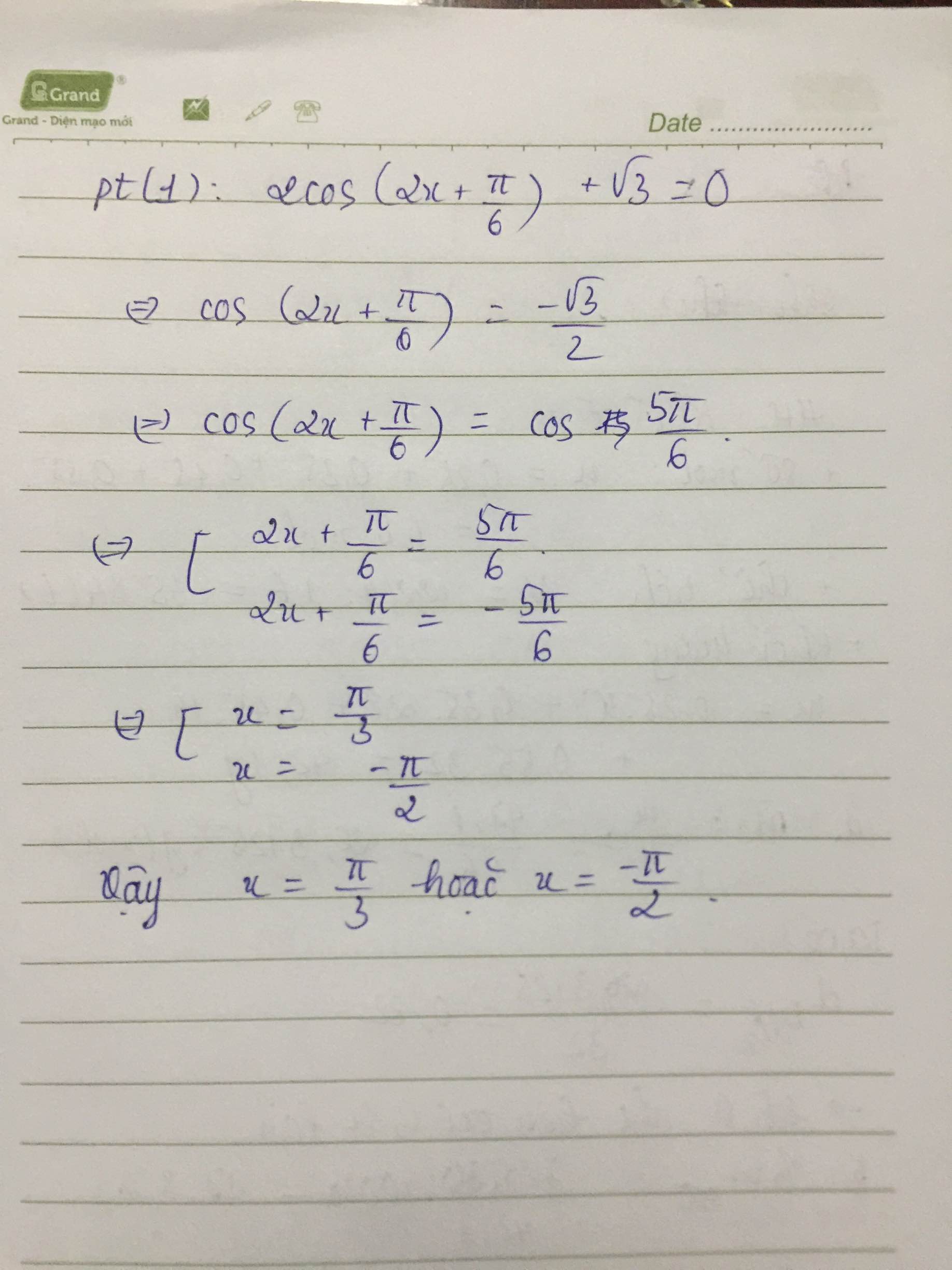
Hãy nhập câu hỏi của bạn vào đây, nếu là tài khoản VIP, bạn sẽ được ưu tiên trả lời.


1.
\(\Leftrightarrow cos\left(2x+\dfrac{4\pi}{3}\right)=0\)
\(\Leftrightarrow2x+\dfrac{4\pi}{3}=\dfrac{\pi}{2}+k\pi\)
\(\Leftrightarrow2x=-\dfrac{5\pi}{6}+k\pi\)
\(\Leftrightarrow x=-\dfrac{5\pi}{12}+\dfrac{k\pi}{2}\)
b.
\(\Leftrightarrow2+2cos\left(2x+\dfrac{\pi}{3}\right)-3=0\)
\(\Leftrightarrow cos\left(2x+\dfrac{\pi}{3}\right)=\dfrac{1}{2}\)
\(\Leftrightarrow\left[{}\begin{matrix}2x+\dfrac{\pi}{3}=\dfrac{\pi}{3}+k2\pi\\2x+\dfrac{\pi}{3}=-\dfrac{\pi}{3}+k2\pi\end{matrix}\right.\)
\(\Leftrightarrow\left[{}\begin{matrix}x=k\pi\\x=-\dfrac{\pi}{3}+k\pi\end{matrix}\right.\)
c.
\(\Leftrightarrow cos\left(2x-\dfrac{\pi}{6}\right)=\dfrac{\sqrt{3}}{2}\)
\(\Leftrightarrow\left[{}\begin{matrix}2x-\dfrac{\pi}{6}=\dfrac{\pi}{6}+k2\pi\\2x-\dfrac{\pi}{6}=-\dfrac{\pi}{6}+k2\pi\end{matrix}\right.\)
\(\Leftrightarrow\left[{}\begin{matrix}x=\dfrac{\pi}{6}+k\pi\\x=k\pi\end{matrix}\right.\)
cho em hỏi làm sao mà từ đề ra được ạ
b) \(\Leftrightarrow2+2cos\left(2x+\dfrac{\pi}{3}\right)-3=0\)
c)\(\Leftrightarrow cos\left(2x-\dfrac{\pi}{6}\right)=\dfrac{\sqrt{3}}{2}\)

\(\Leftrightarrow2cos^2\left(x+\dfrac{pi}{3}\right)-1=0\)
=>\(cos\left(2x+\dfrac{2}{3}pi\right)=0\)
=>2x+2/3pi=pi/2+kpi
=>2x=-1/6pi+kpi
=>x=-1/12pi+kpi/2
mà \(x\in\left(-\dfrac{pi}{2};\dfrac{5}{6}pi\right)\)
nên \(x\in\left\{-\dfrac{1}{12}pi;\dfrac{5}{12}pi\right\}\)

\(\Leftrightarrow2\left(\dfrac{1}{2}cosx+\dfrac{\sqrt{3}}{2}sinx\right)+2cos\left(x-\dfrac{\pi}{3}\right)=2\)
\(\Leftrightarrow cos\left(x-\dfrac{\pi}{3}\right)+cos\left(x-\dfrac{\pi}{3}\right)=1\)
\(\Leftrightarrow cos\left(x-\dfrac{\pi}{3}\right)=\dfrac{1}{2}\)
\(\Leftrightarrow\left[{}\begin{matrix}x-\dfrac{\pi}{3}=\dfrac{\pi}{3}+k2\pi\\x-\dfrac{\pi}{3}=-\dfrac{\pi}{3}+k2\pi\end{matrix}\right.\)
\(\Leftrightarrow\left[{}\begin{matrix}x=\dfrac{2\pi}{3}+k2\pi\\x=k2\pi\end{matrix}\right.\)

ĐKXĐ: \(sinx\ne\pm1\)
\(\dfrac{3cos2x-2sinx+5}{2\left(1-sin^2x\right)}=0\)
\(\Leftrightarrow3\left(1-2sin^2x\right)-2sinx+5=0\)
\(\Leftrightarrow-6sin^2x-2sinx+8=0\)
\(\Leftrightarrow\left[{}\begin{matrix}sinx=1\left(loại\right)\\sinx=-\dfrac{4}{3}< -1\left(loại\right)\end{matrix}\right.\)
Vậy pt vô nghiệm

a: \(2\cdot sin\left(x+\dfrac{\Omega}{5}\right)+\sqrt{3}=0\)
=>\(2\cdot sin\left(x+\dfrac{\Omega}{5}\right)=-\sqrt{3}\)
=>\(sin\left(x+\dfrac{\Omega}{5}\right)=-\dfrac{\sqrt{3}}{2}\)
=>\(\left[{}\begin{matrix}x+\dfrac{\Omega}{5}=-\dfrac{\Omega}{3}+k2\Omega\\x+\dfrac{\Omega}{5}=\dfrac{4}{3}\Omega+k2\Omega\end{matrix}\right.\)
=>\(\left[{}\begin{matrix}x=-\dfrac{8}{15}\Omega+k2\Omega\\x=\dfrac{4}{3}\Omega-\dfrac{\Omega}{5}+k2\Omega=\dfrac{17}{15}\Omega+k2\Omega\end{matrix}\right.\)
b: \(sin\left(2x-50^0\right)=\dfrac{\sqrt{3}}{2}\)
=>\(\left[{}\begin{matrix}2x-50^0=60^0+k\cdot360^0\\2x-50^0=300^0+k\cdot360^0\end{matrix}\right.\)
=>\(\left[{}\begin{matrix}2x=110^0+k\cdot360^0\\2x=350^0+k\cdot360^0\end{matrix}\right.\)
=>\(\left[{}\begin{matrix}x=55^0+k\cdot180^0\\x=175^0+k\cdot180^0\end{matrix}\right.\)
c: \(\sqrt{3}\cdot tan\left(2x-\dfrac{\Omega}{3}\right)-1=0\)
=>\(\sqrt{3}\cdot tan\left(2x-\dfrac{\Omega}{3}\right)=1\)
=>\(tan\left(2x-\dfrac{\Omega}{3}\right)=\dfrac{1}{\sqrt{3}}\)
=>\(2x-\dfrac{\Omega}{3}=\dfrac{\Omega}{6}+k2\Omega\)
=>\(2x=\dfrac{1}{2}\Omega+k2\Omega\)
=>\(x=\dfrac{1}{4}\Omega+k\Omega\)

\(cos\left(2x+\dfrac{\pi}{3}\right)+cos\left(x-\dfrac{\pi}{3}\right)=0\)
\(\Leftrightarrow2cos\dfrac{3x}{2}.cos\left(\dfrac{x}{2}+\dfrac{\pi}{3}\right)=0\)
\(\Leftrightarrow\left[{}\begin{matrix}cos\dfrac{3x}{2}=0\\cos\left(\dfrac{x}{2}+\dfrac{\pi}{3}\right)=0\end{matrix}\right.\)
\(\Leftrightarrow\left[{}\begin{matrix}\dfrac{3x}{2}=\dfrac{\pi}{2}+k\pi\\\dfrac{x}{2}+\dfrac{\pi}{3}=\dfrac{\pi}{2}+k\pi\end{matrix}\right.\)
\(\Leftrightarrow\left[{}\begin{matrix}x=\dfrac{\pi}{3}+\dfrac{k2\pi}{3}\\x=\dfrac{\pi}{3}+k2\pi\end{matrix}\right.\)

Pt \(\Leftrightarrow\)\(tan\left(x+\dfrac{\pi}{3}\right)\)=\(-cot\left(\dfrac{\pi}{2}-3x\right)\)
\(\Leftrightarrow\)\(tan\left(x+\dfrac{\pi}{3}\right)\)=\(tan\left(\dfrac{\pi}{2}+\dfrac{\pi}{2}-3x\right)\)=\(tan\left(\pi-3x\right)\)
\(\Leftrightarrow\)\(x+\dfrac{\pi}{3}=\pi-3x+k\pi\)
\(\Leftrightarrow\)4\(x\)=\(\dfrac{4}{3}\pi+k\pi\)
\(\Leftrightarrow\) \(x=\) \(\dfrac{\pi}{3}+k\dfrac{\pi}{4}\)(\(k\in Z\))
\(pt\Leftrightarrow tan\left(x+\dfrac{\pi}{3}\right)=-cot\left(\dfrac{\pi}{2}-3x\right)\)
\(\Leftrightarrow tan\left(x+\dfrac{\pi}{3}\right)=cot\left(-\dfrac{\pi}{2}+3x\right)\)
\(\Leftrightarrow tan\left(x+\dfrac{\pi}{3}\right)=tan\left(\dfrac{\pi}{2}+\dfrac{\pi}{2}-3x\right)\)
\(\Leftrightarrow tan\left(x+\dfrac{\pi}{3}\right)=tan\left(\pi-3x\right)\)
\(\Leftrightarrow x+\dfrac{\pi}{3}=\pi-3x+k\pi\)
\(\Leftrightarrow4x=\dfrac{2\pi}{3}+k\pi\)
\(\Leftrightarrow x=\dfrac{\pi}{6}+\dfrac{k\pi}{4}\)

\(-1\le cosx\le1\)
Vô nghiệm nha a, \(cos\ge-1\)